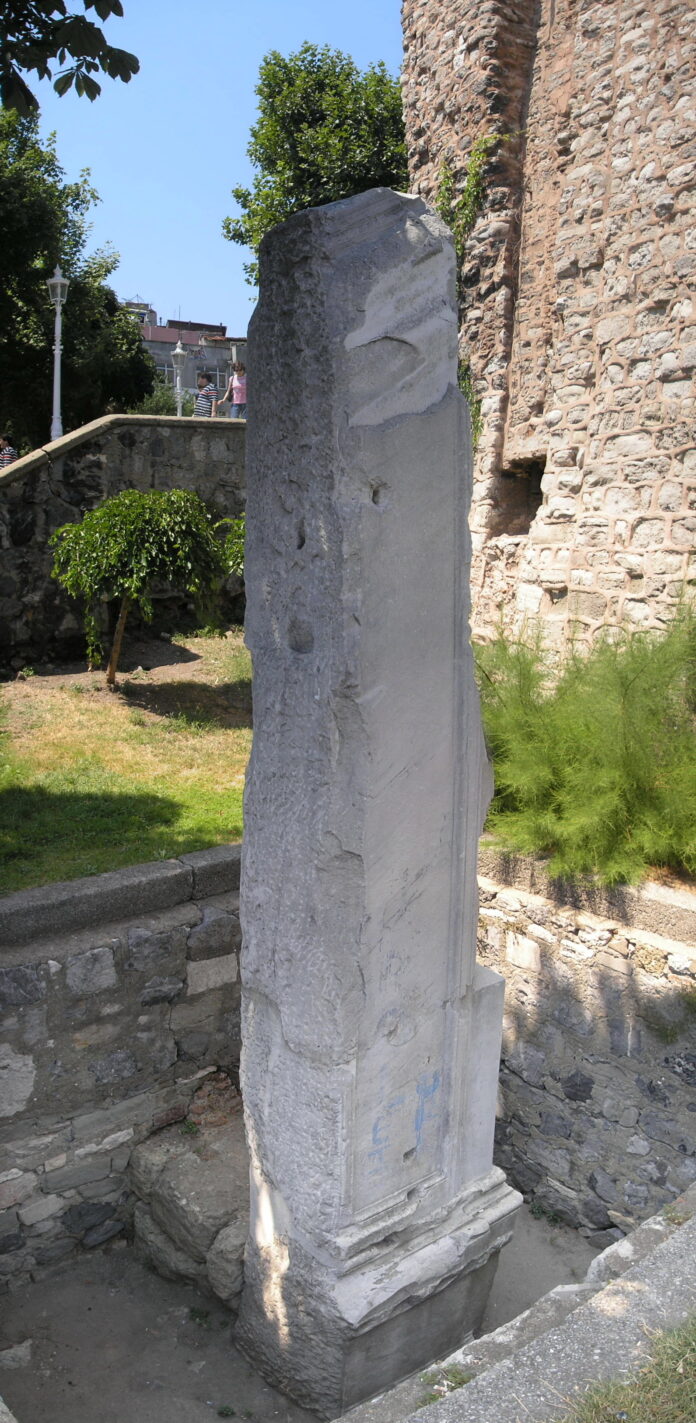No matter where in the world, cities and settlements have a central point. That point is the place accepted as the middle of the city. In ancient times, kilometers were always calculated from that point, maps were drawn accordingly, and caravans traveled accordingly. A monumental stone, a column, a wall, or a monument was erected at this spot, which must have been attributed to some god, a hero, or a commemoration of a past victory.
The center, which was accepted as the “0” point of the city in Istanbul of the Byzantine period, was located at the western end of the Augusteion (Victory) Square, which lies in front of Hagia Sophia. Today, a columnar stone made of Byzantine marble, falling just behind the entrance to the Basilica Palace and rising in a hollow place on the side of the fast tramway, is seen as the only surviving piece of the magnificent Milion Monument, which was once located here and marks the “0” point of the city.
The Milion Monument, which is known as one of the important monuments on Mese, the main street of Byzantium, passing through the middle of the city and ending at the Imperial gate on the Yedikule walls, rising in the shape of a Tetrapylon (on four columns) in Byzantine period Istanbul, was the first to be named after Emperor I.
It was built by Constantine in the late 320s. It is written that during the reign of Justinian I, who ruled Byzantium between 527-565, which is considered as the golden age of Byzantium, it was renewed and decorated with a crown in the form of a sun circle.
The distances of the important centers of the empire to the capital were measured from this monument, and the milestones placed on the roadsides were placed according to the mile calculation made from here. In Byzantine times, roads were calculated on the basis of Roman miles, and 1 Roman mile was equal to approximately 1,480 metres.
In fact, in Rome and other cities, distances between settlements were calculated from the city gates, but Byzantium was calculating this distance symbolically from the Milion Monument.
The “Milion Monument” of Byzantium was a domed structure, supported by arches on all four sides, rising on a square base in the form of a platform, paved with stones, and was once located in front of the Basilica Stoa Church, which was behind the Basilica Palace.
Zosimos and Hesihios, the famous historians of Byzantium, claimed in their histories that the Milion Monument was a monument built in the name of Goddess Tihe, who was respected as one of the pre-Christian gods and the patron deity of the ancient city of Istanbul. As we learned from ancient sources, it is understood that during the reign of Constantine I, there is a statue group showing Emperor Constantine and his mother Helena holding a cross on the eastern façade of the Tetrapylon-shaped monument, and on the same façade, there is a depiction of the Goddess Tihe with a crown on her head and a trumpet in her hand.
During the reign of Justinian I, who ruled the Byzantine Empire between 527-565, when magnificent palaces and churches such as Hagia Sophia, cisterns were built, and the Byzantine Empire expanded its borders from Egypt to the Moroccan coast, the Milion Monument façade was decorated with a sun circle; It is known that during the reign of Emperor Filippikos, who was on the throne for a short time between 711 and 713, religious depictions of Christianity were added, and a sculpture group decorated with the scenes of horse races in the Hippodrome was placed on the monument by Constantine V, who reigned between 741-775. Besides all these, historical sources, They wrote that between the VIII. and XII. centuries, some imperial ceremonies held in Hagia Sophia continued under this monument after the church.
The existence of the Milion Monument, whose ownership was given to the Hagia Sofia Church in 1268, continued for a while in the Ottoman period after the conquest of Istanbul, and after that, it was gradually disintegrated and reached today in its single stone form.
The remains of the Milion Monument were unearthed in 1957, when the area around Sultanahmet Square was organized by the Istanbul Municipality.
The Imperial Gate on the walls of Yedikule, where Mese Street, which passed through the middle of Byzantium, ended in Istanbul centuries ago, was the beginning of the main inter-city road, known as Via Egnatia, which later extended to Rome through the Dalmatian region. From here, on the Via Egnatia route, there were milestones called Hermesia, which were used in ancient Greek and Roman times.
After leaving the city walls of Istanbul, you first arrive at the small fishing village on the coast of Zeytinburnu, which was called Kiklobion cape in Byzantium, then from the Veliefendi Hippodrome to today’s Yenimahalle side, which is decorated with military training and official buildings, and then two important churches, two palaces, It was coming to Hebdomon, where important structures such as monasteries and cisterns are located, that is, the coastal part of today’s Bakırköy.
The reason why Bakırköy was called Hebdomon in the Byzantine period was because the distance from the Million Stone to here was 7 miles, and because of this location, ancient Bakırköy was referred to with the word Hebdomon, which means seventh in Greek. After Hebdomon, he comes to today’s Little Drawer, a military outpost known as Via Egnatia Reghion,
Articles
Across the Island Lesbos
Ancient Egypt’s Tomb Babies: Ushabtis
A Cappadocian Saint: Saint Mamas
Mysterious Bird of Ancient Egypt Ibis
ANKARA SHIP
SAMATYA
Crocodile’s Tears
Makriköy “Şömendöfer” Station
Keeper of Darkness Anubis
A Roaring City: FEZ On One Side
in Egypt’s Western Deserts
Mediterranean on one side The Great Sahara Desert: ALGERIA
Aya Mama Creek
Aya Eirene Church
Baruthane Tower
Rüstempaşa Mosque
8th Wonder of History Hagia Sophia
Statue at Sarayburnu
Holy Oil Miron
A Neighborhood That Continues Its Past SAMATYA
The unknown face of Egypt
Death in Madagascar
Galata Tower
Zero Point of Istanbul: Million Stone
Obelisk
A Cappadocia Tour






















